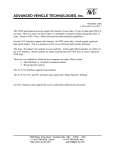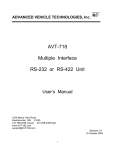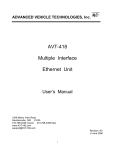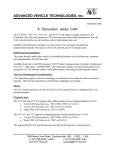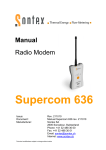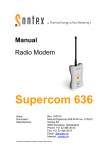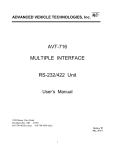Download LIN mode description and operation. (PDF 29K).
Transcript
ADVANCED VEHICLE TECHNOLOGIES, Inc. Inc. AV 18 June, 2002 2 May 2011 AVT-718 LIN Support This document describes LIN mode operations for the AVT-718 interface. LIN mode was first introduced in the AVT-718 firmware version 2.6. Introduction LIN [Local Interconnect Network] is a single wire network similar to ISO 9141, ISO 9141-2, Key Word Protocol 2000 [KWP 2000], and UBP [Ford Uart Based Protocol]. LIN is significantly different in one major respect as compared to many other automotive networks including those supported by the AVT-718: LIN architecture utilizes a Master / Slave arrangement. The AVT-718 LIN mode supports operations as either a Master or a Slave. Firmware To add LIN mode support to an existing AVT-718 requires that the firmware be upgraded. The AVT-718 is a FLASH based device and supports field upgrades of the interface firmware. The code file for the desired firmware version can be obtained from the factory. The factory can also provide two host PC applications to reprogram the AVT-718 FLASH with the firmware code file. One application is a pure DOS program. The other is a 32-bit application for use under MS-Win95/98/NT. Hardware The UBP hardware interface on the AVT-718 is used for LIN communications. A production AVT-718 uses an 18.2 K ohm passive pull-up resistor on the UBP K-line. The LIN specification lists the standard baud rates as: 2400, 9600, and 19200 baud. The AVT-718 will support operations up to and including 9600 baud without any hardware modifications. To support operations at 19200 baud the network must be terminated (passively pulled up to V-batt.) through a 1 K ohm resistor. Note: Unless otherwise indicated, numbers in this document are hex. 1509 Manor View Road, Davidsonville, MD 21035 USA +1-410-798-4038 (voice) +1-410-798-4308 (fax) www.AVT-HQ.com [email protected] Desired network termination can be provided external to the AVT-718 or the AVT-718 can be modified. To modify the AVT-718 resistor R51 is replaced with the desired value. Resistor R51 is a 1/4-watt metal film axial resistor. If R51 is replaced in the field care should be taken to ensure the PC board is not damaged. LIN K-line The LIN K-line signal is present on pin #3 of the Network connector P3 on the AVT-718. [This signal can be found on pin #17 of jumper block JP1 on the AVT-718 board.] Consult the AVT-718 User’s Manual for detailed information about the location of signals on the Network connector as well as means and methods of moving the UBP/LIN signal to another pin. Operation The user should consult the “Master Commands and Responses” document for a complete list of all LIN mode commands and responses. Version 33 was the first released version containing the LIN commands and responses. LIN mode is entered by issuing the mode switch command: $E1 44. The expected response is: $91 19. Once LIN mode has been entered, the AVT-718 is connected to the LIN network and is constantly monitoring the network for messages. Unless commanded otherwise the AVT-718 (in LIN mode) monitors all network activity, will receive all messages, will notify the host of all received messages, and will not transmit anything onto the network. This can be thought of as ‘passive monitor’ mode. Message Received from the Network The AVT-718 is always ‘listening’ to the network. All network messages are received and passed to the host. [The coarse filtering algorithm, known as the Match table, can be enabled by the user, $3x command. The ID byte is message byte #1.] The construction of a received message packet sent to the host is as follows. [Time stamp disabled] 0x yy ID rr ss ... where: 0x = upper nibble “0” indicates from the network lower nibble “x” is the count of bytes to follow yy = received status byte (bit map, below) ID = message ID byte rr ss ... = message data bytes (optional field) [Time stamp enabled] 0x gg hh jj kk yy ID rr ss ... where: 0x = upper nibble “0” indicates from the network lower nibble “x” is the count of bytes to follow gg hh jj kk = microsecond time stamp yy = received status byte (bit map, below) Advanced Vehicle Technologies, Inc. Page 2 ID = message ID byte rr ss ... = message data bytes (optional field) Received Status Byte 7 LIN 6 5 4 3 Error Message Message From this Message node too short decoding received length length without does not code break match format 2 0 1 0 Time-out Checksum error error Received message examples: 04 00 B1 11 22 04 = from the network, four bytes follow. 00 = no errors detected and not transmitted by this node. B1 = message ID byte indicating two bytes of data expected. 11 22 = actual message data bytes. 05 00 B1 11 22 CC 04 = from the network, five bytes follow. 00 = no errors detected and not transmitted by this node. B1 = message ID byte indicating two bytes of data expected. 11 22 = actual message data bytes. CC = checksum byte. [Note: the checksum byte is enabled by the $52 01 01 command.] 06 40 E2 11 22 33 44 06 = from the network, six bytes follow. 40 = transmitted by this node, no errors detected. E2 = message ID byte indicating four bytes of data expected. 11 22 33 44 = actual message data bytes. [Note: this message will only occur if the $52 06 01 command had been sent previously.] 05 C3 E2 11 22 33 05 = from the network, five bytes follow. C3 = bits 7, 6, 1, and 0 all set: [message length didn’t match format, 4 bytes were expected, only 3 were received; data was transmitted by this node; receive buffer timed out waiting for the expected data; checksum error.] E2 = message ID byte indicating four bytes of data expected. 11 22 33 = actual message data bytes. Receive Message Time Out The AVT-718 opens a receive buffer whenever a synch break is detected on the network. At that point the Maximum Frame timer is started (command $5x 52). If a complete message is not Advanced Vehicle Technologies, Inc. Page 3 received before that timer has expired, the contents of the receive buffer are checked and then sent to the host. Any error conditions, such as message length not matching the expected length and checksum, are flagged in the receive status byte. As soon as the Message ID byte has been received the AVT-718 checks the expected length (as defined by the ID byte) against the actual message length. If and when the actual message length matches the expected length, the message is checked and sent to the host. Message Transmitted to the Network The Master or Slave configuration of the AVT-718 is determined on a message by message basis. If not commanded to be either a Master or Slave the interface is in passive monitor mode (described previously). When commanded to transmit a message as a Master, the AVT-718 performs the following: • Check that the network is idle. • Transmit the programmed synch break. The $5x 1D command determines synch break duration. • Wait the programmed synch break delimiter time. [The minimum synch break delimiter time is 10 bit intervals, regardless of the setting using the $5x 53 command.] • Transmit the synch byte, $55. • Transmit the message ID byte. • If no data was specified the AVT-718 will wait for a slave to respond with data. • If data was specified, the AVT-718 will begin transmitting that data. The time interval between transmitted bytes is set by the $5x 27 command (P4_min). • If, during transmission, the received echo of a transmitted byte do not match, transmission is immediately terminated, the transmit message is flushed, and an error message is sent to the host. When commanded to transmit a message as a Slave, the AVT-718 performs the following: • Parse and hold the commanded message. • Wait for the matching ID byte to be received. • The ID byte of every message received from the network is checked against the pending message. • If the ID byte does not match, the transmit routine continues to wait and does not interfere with the message on the network. [The message on the network is received and passed to the host.] • If the ID byte does match, the pending message is transmitted onto the network. The time interval between transmitted bytes is set by the $5x 27 command (P4_min). Advanced Vehicle Technologies, Inc. Page 4 • If, during transmission, the received echo of a transmitted byte do not match, transmission is immediately terminated, the transmit message is flushed, and an error message is sent to the host. • The $21 09 command flushes a pending transmit message (Master or Slave). [The response is $91 18.] • If a matching ID byte is not found within 2 seconds, the pending message is flushed and the host is notified by an error message. Construction of a packet from the host to the AVT-718 is as follows: 0x 0y ID rr ss ... where: 0x = upper nibble “0” indicates to the network lower nibble “x” is the count of bytes to follow y = 0 if Slave mode y = 1 if Master mode ID = message ID byte rr ss ... = message data bytes (optional field if a master) Transmit message examples: 02 01 B1 02 = to the network, two bytes follow. 01 = send this as a master. B1 = message ID byte indicating two bytes of data expected. 04 01 B1 11 22 04 = to the network, four bytes follow. 01 = send this as a master. B1 = message ID byte indicating two bytes of data expected. 11 22 = actual message data bytes. [Note: The AVT-718 performs all the functions of the Master and transmits the data field.] The previous transmitted message will result in the following received message: 02 40 B1 02 = from the network, two bytes follow. 40 = received status byte indicating ‘from this node’. B1 = message ID. 04 00 B1 11 22 04 = to the network, four bytes follow. 00 = send this as a slave. B1 = message ID byte indicating two bytes of data expected. 11 22 = actual message data bytes. [Note: The AVT-718 waits for a message with ID = $B1 before sending the data.] The previous transmitted message will result in the following received message: 02 40 B1 02 = from the network, two bytes follow. Advanced Vehicle Technologies, Inc. Page 5 40 = received status byte indicating ‘from this node’. B1 = message ID. 02 00 B1 02 = to the network, two bytes follow. 00 = send this as a slave. B1 = message ID byte indicating two bytes of data expected. [Note: The AVT-718 will send the error message $23 4B 00 02 to indicate that this message is too short to be a slave.] Error Message During LIN operations the host is notified of most errors through a single error message containing two bytes of bit mapped error conditions. Do not confuse this error message with the received status byte of a message received from the network. The error message has the form: 23 4B xx yy 23 = upper nibble “2” indicates an error message lower nibble “3” indicates three bytes follow. 4B = indicates that this is a LIN error message. xx yy = bit map of error conditions. xx bit 0: bit 1: bit 2: bit 3: bit 4: bit 5: bit 6: bit 7: communications interrupt with unknown cause. communications receiver overrun. communications receiver noise detected. synch byte incorrect value. error decoding receive buffer status. break received, no receive buffer available. no receive buffer available. short to ground detected. bit 0: bit 1: bit 2: bit 3: bit 4: bit 5: bit 6: bit 7: transmit message too short. transmit message too short for slave. error decoding master state variable. received byte does not equal transmitted byte, message flushed. error decoding master state variable. transmit mode time out. master state time out. not defined, always zero. yy Baud Rate [Note: Do not confuse LIN network baud rate with the communications baud rate between the host computer and the AVT-718 interface.] The AVT-718 supports the three specified LIN baud rates of 2400, 9600, and 19200 baud. The default baud rate, when entering LIN mode, is: 9600 baud. Advanced Vehicle Technologies, Inc. Page 6 The $5x 50 command is used to set the AVT-718 to the desired baud rate. The three pre-set baud rates are as defined by the LIN specification. There is fourth means of setting operational baud rate. The $54 50 04 xx yy command permits the user to set the actual baud rate divisor. When using this method, the formula for baud rate is: Firmware versions 2.7 and earlier: Baud rate = 524288 (decimal) divided by (decimal equivalent of xx yy). Firmware version 3.0 and later: Baud rate = 655360 (decimal) divided by (decimal equivalent of xx yy). Example: xx yy = $00 3F = decimal 63; resulting baud rate = 10403 baud; can be used on a 10400 baud network with an error of 0.03% Timing Parameters Some timing parameters are defined as a function of bit times. As a result those parameters are a function of the LIN network baud rate. When the LIN network baud rate is changed (using the $5x 50 command) some timing parameters are automatically changed. The timing parameters affected are: • Synch break delimiter time [$5x 53 command]. • Synch break time [$5x 1D command]. • Maximum frame time [$5x 52 command]. The user is free to change these values, after setting the baud rate, using the desired command. The algorithm used by the AVT-718 to compute the new timing parameters is: • Compute the baud rate divisor (or used the specified divisor). • Integer multiply the baud rate divisor by 19 and integer divide by 10 to obtain the bit time in microseconds. • Save the synch break delimiter time, as 1 bit time. • Integer multiply by 13 to obtain the synch break time and save it. • Integer multiply by 174 to obtain the maximum frame time and save it. Questions ?? Contact the factory by e-mail, phone, or fax. Contact information provided on the bottom of page 1. Advanced Vehicle Technologies, Inc. Page 7







